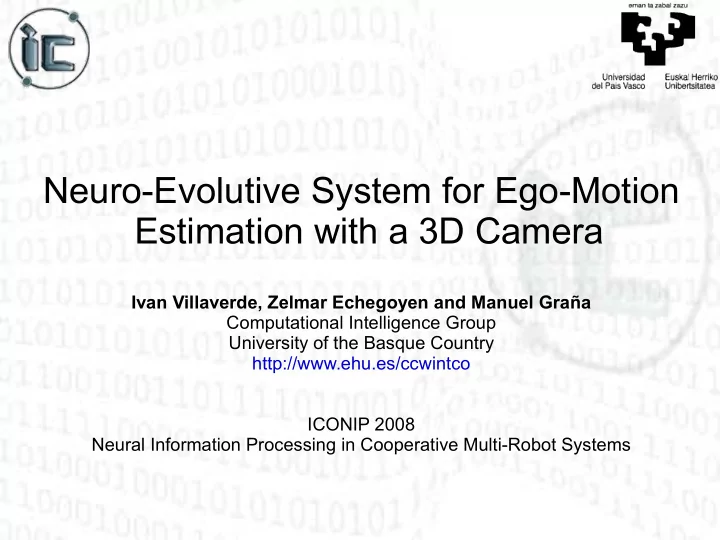

Neuro-Evolutive System for Ego-Motion Estimation with a 3D Camera Ivan Villaverde, Zelmar Echegoyen and Manuel Graña Computational Intelligence Group University of the Basque Country http://www.ehu.es/ccwintco ICONIP 2008 Neural Information Processing in Cooperative Multi-Robot Systems
Contents ● Introduction ● ToF 3D Camera – Data Preprocessing ● Neuro-Evolutive System ● Experimental Settings and Results ● Conclusions
Introduction ● Use of new ToF 3D cameras. ● Final objective: full SLAM capabilities on multirobot systems. ● First step: Learn data processing and feature extraction from the 3D data provided by the camera. ● Simple task: ego-motion estimation.
ToF 3D Camera ● SwissRanger SR-3000 ● Phase measuring Time of Flight principle. ● Led array illuminates the scene. ● Known wavelength amplitude. ● Phase delay used to measure traveled distance.
ToF 3D camera
Data Preprocessing ● Pros: – Full 3D scene information. – On-line operation. – On-board operation. ● Cons: – Big data size. – Ambiguity range. – Specular reflections. – Measurement uncertainty.
Data Preprocessing ● Thresholding confidence value i = I i × D C i €
Neuro-Evolutive System Neural Gas ● First step: Neural Gas used to generate a codevector set that fits the data. ● Codevector set S . ● Keeps the spatial shape of the 3D data. ● Reduces data amount to a fixed, small size. ● Obtained using the SOM Toolbox for Matlab http://www.cis.hut.fi/projects/somtoolbox/
Neuro-Evolutive System Ego-motion Estimation ● Problem Statement: – Robot at time t defined by: ● Position: P t = ( x t , y t , θ t ) ● Observed data: codevector set S t – Time t+1 : ● S t+1 obtained from the camera. ● P t+1 has to be estimated.
Neuro-Evolutive System Ego-motion Estimation ● P t and P t+1 are nearby points in 2D space. ● Same environment, but observed from different PoV. – Most objects visible from P t should be also visible from P t+1 . – S t+1 should be similar to S t , after a slight transformation. – This transformation gives the spatial relation between P t and P t+1 . ● Objective: estimate the transformation T between S t and S t+1 .
Neuro-Evolutive System Evolution Strategy ● An ES is used to search for the transformation T . ● Individuals h i are hypothesis about position P t+1, and their traits the parameters of the transformation T i between P t and hypothesized P t+1 . c o s ( θ i − θ t ) − s i n ( θ i − θ t ) x i − x t h i = ( x i , y i , θ i ) i = s i n ( θ i − θ t ) c o s ( θ i − θ t ) y i − y t T 0 0 1 €
Neuro-Evolutive System Evolution Strategy ● For each hypothesis h i we have a prediction of the observed grid: S t 1 i = T i × S t ● Fitness function as a matching distance between codevector sets, computed as the sum of the euclidean distances from each codevector in to S t 1 i its closest codevector in S t+1 . ● Initial population built randomly from h 0 = (0, 0, 0) (i.e. No transformation: the robot has not moved). – Optionally, an a priori estimation can be used.
Neuro-Evolutive System Algorithm Flow Diagram Cloud Intensity Image Neural S t+1 Filtering Distance Image of Points Gas S t Fitness Transformation P t P t+1 P t 1 Selection Population Mutation
Experimental Settings ● Pre-recorded walks. – Odometry and optical views as reference. – Very noisy 3D images due non-optimal configuration. ● Experiment result: Sequence of transformations T = ( T 1 ,..., T t ). – Robot position at time t : P t = T t x ... x T 1 x P 0 ● 100 node codevector sets.
Experimental Settings ● Evolution strategy implementation: – Population of 20 individuals. – New generation: ● The 1/3 best fitted directly. ● Remaining 2/3 generated from them, crossing pairs and mutating traits with 50% probability. – Fitness function as a matching distance between codevector sets, computed as the sum of the euclidean distances from S t 1 i each codevector in to its closest codevector in S t+1 . – Stopping condition: Best fitted have the same orientation and are within a threshold euclidean distance.
Experimental Results ● Matching results: S t = · = * S t 1 i S t+1 = o
Experimental Results ● Correct ego-motion estimation:
Experimental Results ● Erroneous ego-motion estimation:
Conclusions ● Mobile robot ego-motion estimation algorithm. – 3D camera measurements. – Neuro-Evolutive system. ● Neural Gas. ● Evolution Strategy. – Correct estimation with good matching features. ● Future work: – Integration in a Kalman or particle filter SLAM architecture. – 3D environment reconstruction. – Use of point cloud registration techniques.
Questions, by Oberazzi http://www.flickr.com/photos/oberazzi/318947873/
Recommend
More recommend